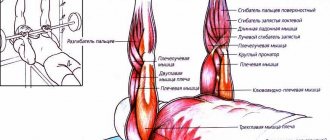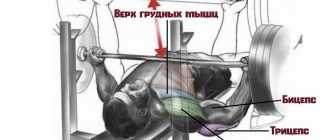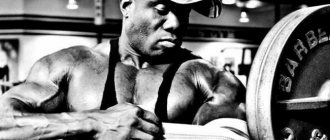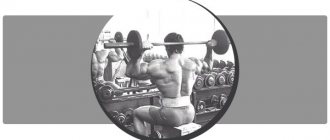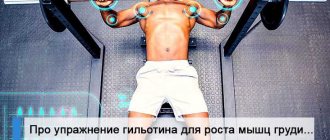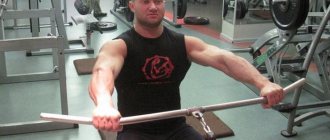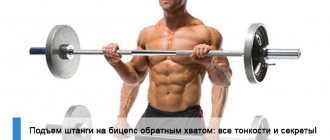Benefits and features of the barbell clean
This is an extremely effective exercise and is designed to increase strength, muscle mass, explosiveness and endurance. Barbell cleans are an excellent aerobic exercise option. The exercise develops most muscles, such as deltoids, trapezius, quadriceps and buttocks, allows you to work with heavy weights, and accordingly, testosterone production increases from performing chest lifts.
The clean helps improve performance in exercises such as the snatch, front squats, deadlifts, good mornings, thrusters.
Creating a program
The exercise is performed in sets of 1-3 repetitions, in some cases 5 repetitions are possible. When working on technique, the weight should remain light (75% of the possible maximum and below). To work on aggressiveness and stretching when diving (squatting) under the bar, you should use a heavier weight (75% or higher). If the exercise is used as a lighter version of the classic Barbell Clean, then the weight can vary depending on the needs of the athlete, but most often it is about 70-80% of the possible maximum. For pure speed work the weight should be around 65-75%.
What muscles work during a power clean?
The main load when performing this exercise is received by:
- Gluteal group.
- Quadriceps femoris muscle.
- Deltoids.
- Trapezoid.
Also, the load applies to the biceps femoris, spinal erector muscles and abdominal muscles.
Technique for performing barbell lifts from a platform
So, the exercise technique is very complex. To make it easier to understand the technique, we will separately analyze the stall, cast and hook.
Where to begin? The first thing you need to understand is that you need to strictly follow the technique, since the exercise can be very dangerous to health.
The starting position is as follows:
- The athlete stands at the barbell with his feet shoulder-width apart and the bar as close to his shin as possible.
- Pay attention to the center of gravity. It should be on the heels, the back remains straight throughout the entire approach of the exercise.
- You need to sit down and grab the bar with an overhand grip. The shoulders should be pulled back, the trapezius muscles should be kept tense, and the lower back should be slightly arched.
- The legs are bent at the knee joints at approximately 45 degrees. In this position, we begin lifting the barbell to the chest.
Disruption
The task of this stage is to remove the sports equipment from the floor. The exercise differs from the deadlift in that the athlete will perform the movement with a wider amplitude. Therefore, the movement is carried out with great inertia.
Casting
As soon as the bar rises just above the knee joints, the athlete begins lifting the barbell to the chest. At this stage, he makes a pulling movement with his shoulders, moving them back a little. The movement is similar to pulling a barbell to your chin. Here you need to connect the elbow joints. In weightlifting, athletes stand on their toes when lifting the barbell. This nuance increases the inertial force. In my opinion, the feet should not leave the floor.
Podsed
As soon as the sports equipment reaches the level of the maximum point of movement, the athlete does a squat. At this point, the athlete should lower his elbows and do a squat. One significant point is that the depth of the squat depends on the working weight. The heavier the weight, the lower the squat is performed. If the movement is done correctly, the bar of the bar should fall to the top of the chest.
Complete equipment in GIF format
Lifting objects from the floor with your fingers
The student must adapt this exercise to himself, using any object that can be lifted and secured to a bent finger, for example: a chair, a suitcase, a bucket of coal. The weight is gradually increased, placed on the inner joint of the middle finger or any other at the level of the body, or raised between the legs, while standing on strong chairs or any platform. Mr. Sandow's finger lift record is 600 pounds ( 272 kg ). When lifting this weight, it usually stands on an elevated stage and platform on which stand the people or objects intended to be lifted. In all heavy lifting, care should be taken to keep the back straight to prevent sprains and tears, and to put the main pressure on the legs. When lifting with your right hand, your left should find a fulcrum, resting on your left thigh, and vice versa.
Technique options
In addition to the classic barbell clean, there are other options for performing the exercise.
With broach or semi-broach
The peculiarity of this type of exercise is the higher position of the pelvis in the initial position. More active work falls on the muscles of the back and arms.
Half-sitting
This exercise allows you to use heavy weights. The disadvantages include the slow pace of the exercise.
Stand up
This option makes it possible to work with a weight of 80% of the maximum.
In the rack - half-stretch
Involves lifting the heel off the floor. The exercise is performed with greater inertia and at a fast pace. The emphasis of the load falls on the back and arms. Effective for developing explosive strength. This version of the exercise is used in American football.
In the rack - power pull
This type of broaching involves working with light weight. Basically, only the back is involved in the work. The fastest pace of execution is required. There is minimal development of explosive force here. Standing on your toes (lifting your feet off the floor) is undesirable in this option.
Lifting the barbell to the chest from hanging - on the rebound
This technique involves working with light weights at a fast pace. This exercise is highly energy-intensive and develops endurance and explosive strength.
Hanging – from mid-thigh
The exercise is designed to work with heavy weights. The movement is performed by working the back and legs. The execution speed of this option is slow.
From hanging - from knees
The exercise differs in that the load is distributed to a greater extent on the hamstrings. The technique is performed at a slow speed.
BAR PRESS WITH LIFT FROM THE FLOOR
Purpose of the exercise: Training the anterior and lateral deltoid muscles; building muscle mass and muscle strength.
You lift the barbell off the floor and into the starting position for a military press. So the movement starts with using the legs to lift the weight off the floor and then engages the trapezius, arm and shoulder muscles to develop true Herculean muscles.
Execution: (1) Squat down, lean forward and grab the barbell with an overhand grip, hands shoulder-width apart. (2) With your legs straight, lift the barbell to shoulder height, then bend back slightly to support the barbell in the starting position of a military press. (3) Using the muscles of the shoulder girdle and forearm, press the barbell overhead, then lower it to shoulder height and repeat the movement in reverse, bending your knees and placing the barbell on the floor.
Lee Hany
BAR PRESSES ON A MACHINE
Purpose of the exercise: To train the anterior and lateral deltoid muscles.
Machine presses help you perform the movement with great precision and keep the barbell off the floor if you have any problems with your lower back. Additionally, you can lower the weight much lower, which allows for additional stretching of the anterior deltoids. There are several machines on which you can perform this exercise - Cybex, Nautilus, Hammerstens, Universal and others - but the principle remains the same.
Execution: (1) Grasp the barbell or handles at shoulder level.
(2) Squeeze the bar upward until your arms are completely straight, then slowly lower it back to the starting position. You can also use cross-grip or overhead press machines to work your anterior and lateral deltoids.
RODS
Purpose of the exercise: When using a weight heavier than normal or continuing barbell shoulder presses after failure; to develop additional deltoid muscle strength.
This exercise uses the principle of "cheating". You can use it during strength training to lift a barbell that is too heavy for you to do with regular shoulder presses. Barbell slings can also be used for forced reps at the end of a series when you are very tired and cannot perform shoulder presses with strict form.
Execution: (1) Grasp the barbell with an overhand grip, with your hands slightly wider than shoulder-width apart. Hold the apparatus at shoulder level.
(2) Bend your knees slightly and give an initial push with your legs to send the barbell upward. Use this extra force to press the barbell overhead. Fix it in the upper position, then smoothly lower it to shoulder level.
David Dirt
STRAIGHT ARM RAISES WITH DUMBBELLS IN A STANDING POSITION
Purpose of the exercise: Development of the lateral head of the deltoid muscle with additional load for the anterior and posterior head of the deltoid muscle.
Execution: (1) Hold a dumbbell in each hand, lean forward slightly and extend your lowered arms in front of you. Begin each rep with a clear stop to avoid swinging the dumbbells. (2) Lift the dumbbells up and out to the sides, turning your wrists slightly as if pouring water from a jug (so that the back of the dumbbell is higher than the front). (3) Raise the dumbbells slightly above your shoulders, then slowly and smoothly lower them down. (A common mistake with this movement is rocking back and forth and swinging dumbbells instead of constantly engaging the deltoids. This dramatically reduces the effectiveness of the exercise.)
Variation: When performing the exercise in a standing position, you may have a tendency to “cheat.” This can be avoided by sitting.
Eddie Robinson
Straight arm raises with dumbbells in a sitting position.
Features of the barbell hang clean
This option is perfect for beginner athletes due to the fact that it is technically simpler and involves fewer muscles, joints and fewer movements. Athletes who are in good physical condition can use heavy weights. By the way, this option uses less explosive force.
Execution technique
Correct handling requires concentration and adherence to the main distinguishing features when implementing it: a thorough warm-up, warming up the ligaments and tendons, accuracy and attentiveness.
The hip snatch is performed as follows:
- From the squat position, take the bar shoulder-width apart, with a straight grip and a straight back - 45 degrees to the platform. Arms straight and shoulders, toes in a single plane.
- Taking a breath, you sharply lift your foot off the floor and jump slightly, secretly straightening your torso, leaning back 5-7 centimeters, and pulling the barbell to your chin.
- After this, you sit up sharply, lifting it up and straightening your torso. The weight after the empirical jerk should be located at the end point on the clavicular part.
- Having finished this, it makes sense to straighten your legs and return to their original state, not throwing, but controlling the descent to the original place, carefully along the base of the body.
In such movement, a person’s strict positions at stages are a determining indicator
Graduality and attention will allow you to master the action while minimizing negative consequences
It is necessary to act from a hanging position alternatively, using technology. But the complex contains cautionary aspects, namely the reverse return amplitude of execution:
- After the squat, the first stage of the deadlift is performed, that is, taking the bar from the floor on a straight back - 45 degrees to the floor and bringing it to knee level, holding it for 2-3 seconds.
- Then, with an amplitude explosion, throw and fix the barbell on the front deltas, more precisely the upper clavicular part.
- After this, the reverse stage of the action is performed without throwing the equipment, due to the risk of damage. Or a repeated movement is carried out for the purpose of additional pumping.
- Throwing up a freely hanging projectile is risky and dangerous for a person. The reason for this is a possible displacement of the spine, popularly called a back slip.
What works
An inquisitive athlete who doubts and often asks the question: What will I get in this case? What muscles work?
When mastered correctly and skillfully, it includes: the neck, the front and back surfaces of the legs, and the buttocks. Essentially, this occurs due to impulse output and leg extension.
The abdominal press is a balanced pendulum that balances and maintains the correct ratio of the upper back, feet, grip density to the lower back.
The hands, as a source of directed effort, function like throwing levers. Essentially, a larger volume is allocated to the hands, while they receive only indirect pumping. The forearms and collarbones are assigned a rotational role.
Recommendations for training
Before performing any lifting option, you must do a full warm-up and warm up your joints, ligaments and muscles. This exercise puts a lot of stress on the elbow and wrist joints and hamstrings. You can use elastic bandages for the elbow and knee joints.
Do not round your lower back at any stage of the exercise or use heavy weights. An athletic belt will not protect against lower back injuries.

